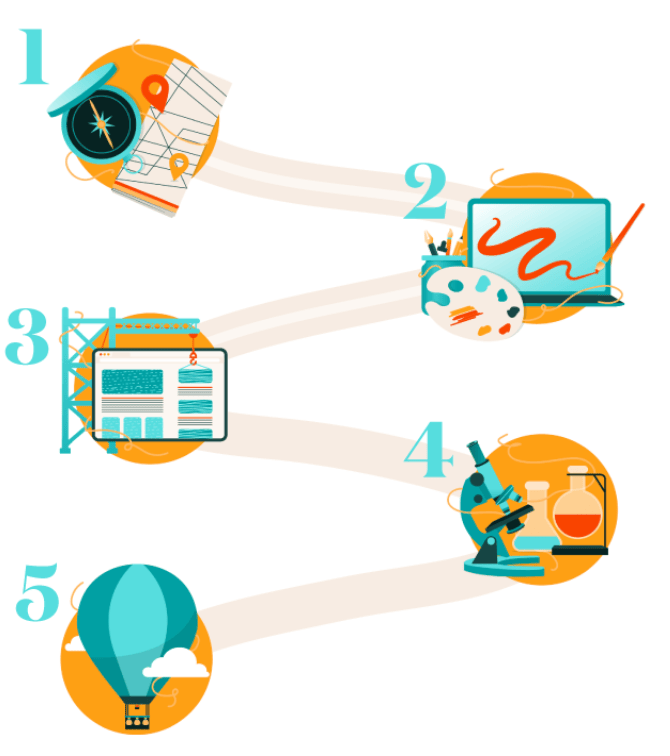“Can you build a website in a day?” Many business owners want to know if crafting a fully functional and visually appealing website in 24 hours is possible. Given tight budgets and high expectations for returns on investment, building an engaging site through a solid web development process is an achievable goal but comes with notable challenges and limitations.
Offering quick and efficient web development solutions could be a game-changer for many marketing agencies and freelancers. However, overpromising on deadlines and quality should be avoided at all costs.
What affects the web development process?
While many tools can create a couple of content pages that look like a site, the intricacies of crafting something that resonates with clients’ visions and objectives extend beyond mere template selection.
Ultimately, the project’s scope, goals, functionalities, design, and user experience shape the web development process. Ensuring the site is visually appealing and user-friendly and includes a content strategy that will help it rank in the correct searches is critical to future success. Technical complexity, involving custom features and third-party integrations, significantly impacts development time.
The process also entails rigorous testing for functionality and performance. Client feedback and regulatory compliance further influence the timeline and complexity, making efficient management and clear communication essential for a successful project.
Critical factors influencing web development duration
Various critical factors influence the Web development process, and understanding them is essential for setting realistic timelines and expectations. Here’s a look at the key elements that impact the duration of web development projects:
- Strategic planning: Collaborating closely with clients to crystallize their vision and requirements is the foundational step that dictates the complexity and timeline of the project.
- Design dynamics: Whether opting for a bespoke design or modifying existing templates, the design phase demands attention to detail and a keen eye for aesthetics.
- Content creation: Beyond mere text, content encompasses the essence of the client’s message, requiring time for research, optimizing for SEO, and compelling the audience with copywriting.
- SEO considerations: Search engines dominate web traffic navigation, making SEO’s role in web development pivotal and vital for long-term success.
- Technical development: This phase involves both front-end and back-end tasks, essential for ensuring the site’s functionality and user experience.
- Quality assurance: Thorough testing for usability, bugs, and performance before launch is critical to ensuring a smooth user experience.
- Launch & review: While the actual launch might be swift, the subsequent review process is crucial for identifying and rectifying any overlooked issues.
Can you build a website with these goals in 24 hours?
Compressing all stages of web development into a single day could compromise quality, resulting in a product that may not fully meet client expectations or technical standards.
Certain business models and industries might find a one-day website an appealing and practical solution despite its inherent limitations. This section will explore specific cases such as small retailers, home-based businesses, and service providers like plumbers and electricians, for whom a basic online presence could suffice.
What’s the ideal timeline for crafting business websites?
Creating a small business website that meets client expectations and quality standards requires a balanced timeline. While the duration can vary based on project complexity, a general framework can guide the process.
- Step one: Discovery and Planning. Begin with client consultations to understand their vision, target audience, and essential functionalities. This phase sets the groundwork for the project’s scope and requirements.
- Step two: Design and Content Strategy. Design mockups and UX/UI plans are developed. Concurrently, outline the content strategy, ensuring it aligns with SEO best practices and speaks to the target audience.
- Step three: Development. With designs and content direction set, start building the website. This includes front-end and back-end development, ensuring responsive design across devices.
- Step four: Testing and Revisions. Conducting rigorous testing for functionality, user experience, and compatibility across browsers and devices is crucial. Based on client feedback, address any issues and make necessary revisions.
- Step five: Launch Preparation. Finalize SEO elements, set up analytics, and ensure all content is integrated and polished. Prepare for launch with a comprehensive review.
- Step six: Launch and Post-Launch Review. Go live with the website, followed by closely monitoring for any issues. Collect initial feedback for potential immediate adjustments.

Depending on functionality and customer features, there’s no standard timeline for creating and launching a business site. However, having a clear plan to follow and trace can avoid issues with delays, missing content, and elements.
Balancing speed and quality in web development
The depth of web development requirements demands a balance, ensuring that speed does not compromise quality. By adhering to a structured yet flexible timeline, developers can deliver websites that meet small business clients’ immediate needs and establish a solid foundation for their digital presence. Ultimately, the goal is to create a website that is both timely delivered and built to last, striking a balance that benefits all.
Learn more about the Perfect Afternoon’s process and how we can help with your next project.
